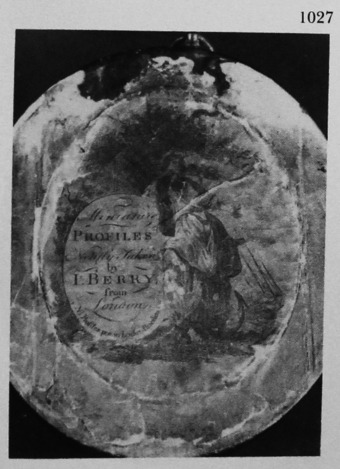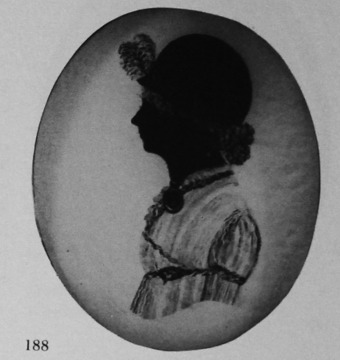Berry, I. (McKechnie Section 3)
Recorded by Mr J. A. Pollak ('Fresh Light on Silhouette, Connoisseur, March 1949). Berry's trade label states that he is 'from London', which suggests that he worked in the provinces as an itinerant artist. His use of a printed label suggests that he executed more work than the paucity of extant examples indicates. To judge from his work, he flourished at the very end of the eighteenth century. It seems more than likely, especially in view of his elaborate engraved trade label, that the artist was J. Berry, recorded by Bénézit as working during this period as a mezzotint engraver.
The illustrated example (in Chapter Six) shows good painting on the under surface of slightly convex glass. The fingerprinting technique was used to show the fashionable transparent material of the woman's dress, and a needle was used to scratch in the detail of the hair, the hat, and the embroidery on the dress. A minor fault is the rather too low placing of the eyelash. The silhouette is longer than some dating from this period, being almost half-length. Its size is 3¼ x 2½ in. The silhouette is in a pearwood frame and backed with silk. The dress suggests a date of c. 1798-1800.
The one known trade label (from the reverse of the illustrated silhouette) was probably engraved by Berry himself. It shows the figure of 'Hope' on a base which incorporates an anchor; the background shows a ship in a stormy sea. On the folds of 'Hope's' cloches can be read the words 'Miniature Profiles neatly Taken by I. Berry from London. NB. Profiles put in Lockets, Bracelets, &c.'
Ills. 188, 1027

Trade Label of I. (or J.) Berry.
J. A. Pollak collection

Unknown young woman
Silhouette by I. Berry, c. 1798-1800
costume dating points
The hair, cut much shorter than was fashionable at the beginning of the decade.
The classical gown of the style fashionable during the 1790s.
The high neck suggests a date late in the decade. The style of the sleeve, typical of the turn of the century.
The round hat, or bonnet, quite different from the hats with the tall crowns worn earlier in the decade, suggests the late 1790s.
J. A. Pollak collection
SECTION THREE
